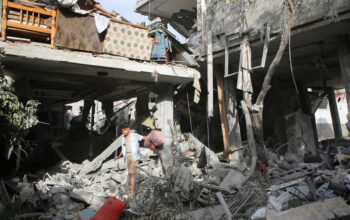
MELBOURNE, Australia — Nearly 95 percent of adults are vaccinated. The coronavirus is now milder. It’s the heart of summer, after a long year and a half of snap lockdowns and closed borders.
Australia, the government says, is ready to “live with the virus,” ready for the authorities to get out of people’s lives and let them make their own health decisions. Hit the pub, enjoy life, spend some money.
But many Australians, it seems, weren’t ready.
When one state announced that it was ending intensive contact tracing, a Facebook group popped up so people could do their own. After Australia’s prime minister declared lockdowns a thing of the past, so many residents of its two biggest cities stayed inside anyway as Omicron spiked that it was labeled a “shadow lockdown.” And even as the country’s borders opened for the first time since March 2020, this travel-loving nation mostly stayed put.
“That shift from ‘Covid is the worst thing imaginable’ to suddenly ‘it’s OK, we just open the floodgates now,’ I think that caused a lot of insecurity in people,” said Simon Benson, a doctor in Melbourne who has been inundated with calls from patients unsure what to do after testing positive.
Perhaps more than any other country, Australia in recent weeks has gone through a dizzying U-turn in its approach to the pandemic. For 18 months, it snuffed out every Covid outbreak, often through considerable public sacrifice. Then, late last year, the government declared itself done with all that: Australia would now “stare down” Omicron and “not go back.”
Suddenly, a nation that once imposed lockdowns over handfuls of cases was dealing with half a million active infections. Deaths, while still few by American or British standards, reached record highs. Australians accustomed to following official guidance and taking collective action to blunt a dangerous virus felt whiplash. And as case numbers started to fall, anxiety bled into resignation.
The country went from “lockdowns when you can’t even have another person visit your house to full pubs, clubs, ‘don’t worry about it,’” said Peter Collignon, a physician and professor of microbiology at the Australian National University.
Australia has taken a plunge that other countries in the Asia-Pacific region have been unready to emulate.
When Omicron started to circulate, many paused or rolled back promised reopenings. Japan reversed a decision to start letting in some students and businesspeople, South Korea suspended quarantine exemptions for incoming travelers, and Thailand halted a newly launched program to bring back tourists.
Understand the Supply Chain Crisis
But Australia stuck to its plan, relaxing mask mandates and other restrictions and reopening its borders to international students and other visa holders. With a federal election looming and many Australians having endured hundreds of days of strict lockdown, Prime Minister Scott Morrison said the country had to “move from a culture of mandates to a culture of responsibility.”
The key to reclaiming Australia’s suspended freedoms, Mr. Morrison said, was its vaccination campaign. But Omicron upended the widespread, if unrealistic, belief that high vaccination rates would end the threat of large-scale outbreaks, said Nancy Baxter, the head of the University of Melbourne’s school of population and global health.
“That was the narrative: ‘We’re all going to get vaccinated, and then we’re going to be able to party like it’s 2019,’” she said.
Instead, case numbers surged to previously unimaginable heights. The Omicron tide peaked at 150,000 new daily cases on Jan. 13. Before this wave, the country had never reached 3,000 cases in a day. And last Friday, Australia had its deadliest day of the pandemic, reporting 98 deaths.
The speed with which the variant spread left the authorities little time to acclimatize the population to the idea of widespread infection.
“It was kind of a ‘hope for the best and plan for the best’ approach,” Professor Baxter said. “So I think there’s a lot of resentment now about vaccines not being enough — whereas they would never have been enough.”
This week, Mr. Morrison conceded that the authorities had raised people’s expectations for a summer rebirth too high.
“I think we were too optimistic, perhaps, and we could have communicated more clearly about the risks and challenges that we still faced,” he said.
To some in Australia, the abrupt shift looked like a political decision after months in which the pandemic response was nonpartisan and led by scientific experts, with clear lines of communication from the authorities to residents.
It’s unclear how the reopening will affect the election, which must be held by May. But Mr. Morrison, a conservative who first took office in 2018, is trailing in polls and has faced criticism as virus response systems have buckled under Omicron.
The country’s testing program, designed to quickly trace and contain small outbreaks, was quickly overwhelmed, with residents lining up outside centers overnight and some samples ruined because they sat around too long. Rapid antigen tests were also in short supply, which led retailers to charge more and prompted an investigation into allegations of price-gouging.
With caseloads skyrocketing, labor shortages became acute, hitting supply chains and leaving supermarket shelves bare. The situation was so dire that the government briefly considered letting juveniles drive forklifts.
Hospitals canceled elective surgeries and urged patients not to go to emergency rooms unless absolutely necessary. Deaths in nursing homes spiked, making up a third of all coronavirus-related fatalities in January.
In the face of these problems, some states reimposed mild restrictions in early January, closing nightclubs and reintroducing density limits. Western Australia, the only state still trying to suppress the virus, has delayed reopening its borders to the rest of the country.
How the Supply Chain Crisis Unfolded
The pandemic sparked the problem. The highly intricate and interconnected global supply chain is in upheaval. Much of the crisis can be traced to the outbreak of Covid-19, which triggered an economic slowdown, mass layoffs and a halt to production. Here’s what happened next:
Still, the worst of this Omicron wave may be over. Hospitalization rates have stabilized, and the health care system has avoided collapse. Death rates remain among the lowest for wealthy nations.
“If we want to compare ourselves to how the rest of the world has gone, we’re doing really well,” said Ian Mackay, a virologist at the University of Queensland.
But that’s not a standard all Australians are happy using, after having given up so much for so long to keep hospitalizations and deaths as close to zero as possible. “And I’m not sure I am either,” Professor Mackay said.
In Melbourne, where residents endured a total of 262 days of lockdown, able to leave home only to buy food or exercise, the whiplash has been particularly severe.
“We’ve been told it’s important to do everything we can to stop the spread, and now suddenly we’re being told we don’t have to,” said one resident, Laura Brennan, 26. “It’s a bit of a roller coaster.”
Ms. Brennan said she was so mentally exhausted that she had no energy for fear or panic as infections soared. While she still follows government restrictions, she said, she’s trying to live a normal life, going out with friends and taking a vacation in Tasmania.
Others, like Lisa O’Halloran, 36, went into self-imposed lockdowns as case numbers rose, getting groceries delivered and strictly limiting time spent outside the home.
As case numbers have fallen, Ms. O’Halloran has loosened up a bit but is still cautious. “I’m trying to find the balance between not going stir-crazy and physical health risk,” she said.
In South Australia, where the contract-tracing Facebook page was started, its activity has declined. More people have gotten used to the idea of living with the virus, said Luke Anderson, a moderator of the group, which has over 190,000 members.
Setting aside issues like the lack of rapid antigen tests and supply chain snarls, he said, “life isn’t really that bad.”
“It’s taken myself quite a while to come around to that,” he added. “I think it’s taken a lot of people a while. But I think it’s the right way.”
John Yoon and Manan Luthra contributed reporting.



